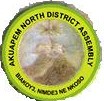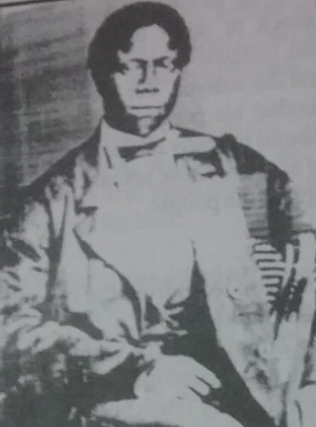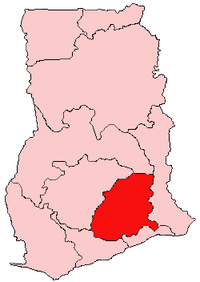Asante, also known as Ashanti, Ashante, or Asante Twi, is one of the principal members of the Akan dialect continuum. It is one of the three mutually intelligible dialects of Akan which are collectively known as Twi, the others being Bono and Akuapem. There are over 20 million speakers of the Asante language, mainly concentrated in Ghana and southeastern Cote D'Ivoire, and especially in and around the Ashanti Region of Ghana.
Akan is a group of several closely related languages within the wider Central Tano languages. These languages are the principal native languages of the Akan people of Ghana, spoken over much of the southern half of Ghana. About 80% of Ghana's population can speak an Akan language as a first or second language, and about 44% of Ghanaians are native speakers. There are populations of polyglots in Ghana who speak an Akan language as a third language. They are also spoken in parts of Côte d'Ivoire.

The Ashanti Region is located in the southern part of Ghana and is the third largest of 16 administrative regions, occupying a total land surface of 24,389 km2 (9,417 sq mi) and making up 10.2 percent of the total land area of Ghana. It is the most populated region in Ghana, with a population of 5,440,463 according to the 2021 census, accounting for around one-fifth of Ghana's total population. The Ashanti Region is known for its gold bar and cocoa production. The largest city and capital of Ashanti is Kumasi.

The Eastern Region is located in the Eastern part of Ghana and is one of the sixteen administrative regions of Ghana. Eastern region is bordered to the east by the Lake Volta, to the north by Bono East Region and Ashanti region, to the west by Ashanti region, to the south by Central region and Greater Accra Region. Akans are the dominant inhabitants and natives of Eastern region and Akan, Ewe, Krobo, Hausa and English are the main spoken languages. The capital town of Eastern Region is Koforidua.The Eastern region is the location of the Akosombo dam and the economy of the Eastern region is dominated by its high-capacity electricity generation. Eastern region covers an area of 19,323 square kilometres, which is about 8.1% of Ghana's total landform.
Asamankese is a town in south Ghana and is the capital of West Akim Municipal District, a district in the Eastern Region of south Ghana. Asamankese has a 2013 settlement population of approximately 39,435 people. Asamankese is on the main highway to Kumasi and Accra in the interior. The people of Asamankese celebrate the Obuodwan festival.

Ghana is a multilingual country in which about eighty languages are spoken. Of these, English, which was inherited from the colonial era, is the official language and lingua franca. Of the languages indigenous to Ghana, Akan is the most widely spoken in the south. Dagbani is most widely spoken in the north.
Articles related to Ghana include:

The Akyem are an Akan people. The term Akyem is used to describe a group of four states: Asante Akyem, Akyem Abuakwa, Akyem Kotoku and Akyem Bosome. These nations are located primarily in the eastern region in south Ghana. The term is also used to describe the general area where the Akyem ethnic group clusters. The Akyem ethnic group make up between 3-4 percent of Ghana's population depending on how one defines the group and are very prominent in all aspects of Ghanaian life. The Akyem are a matrilineal people. The history of this ethnic group is that of brave warriors who managed to create a thriving often influential and relatively independent state within modern-day Ghana. When one talks of Ghanaian history, there is often mention of The Big Six. These were six individuals who played a big role in the independence of Ghana. Of the big six, people of Akyem descent made up the majority.
Agogo is a town in the Asante Akim North Municipal District of the Ashanti Region of Ghana. Agogo is approximately 80 kilometers east of Kumasi, the capital of the Ashanti Region, and had a population of 28,271 in the 2000 census. Computer projections estimate that the 2007 population was 32,859.

Akropong is a town in South Ghana and is the capital of the Akuapim North District, a district in the Eastern Region of South Ghana. This town is known for producing snails and palm oil. Akropong has a 2013 settlement population of 13,785 people.
Bono, also known as Abron, Brong, and Bono Twi, is a Central Tano language common to the Bono people and a major dialect of the Akan dialect continuum, and thus mutually intelligible with the principal Akan dialects of Asante and Akuapem, collectively known as Twi. It is spoken by 1.2 million in Ghana, primarily in the Central Ghanaian region of Brong-Ahafo, and by over 300,000 in eastern Ivory Coast.
Pepease is the second largest town in the Kwahu East District, in the Eastern Region of Ghana.
Abusua is the name in Akan culture for a group of people that share common maternal ancestry governed by seven major ancient female abosom (deities). The Abusua line is considered to be passed through the mother's blood . There are several Abusua that transcend the different ethnic subgroups outside of the ancient seven. People of the same Abusua share a common ancestor somewhere within their bloodline, which may go back as far as thousands of years. It is a taboo to marry someone from the same Abusua. The different Abusua are the Agona (parrot), the Aduana (dog), the Asenie (bat), Oyoko (falcon/hawk), the Asakyiri (vulture), the Asona (crow), the Bretuo (leopard), and the Ekuona (bull).
The Akuapem, one of the main ethnic groups of the Akan people, reside mostly to the south of the Eastern Region of Ghana. They are indigenous, consisting of both patriarchal Volta-Comoe-speaking Guans and matriarchal Kwa-speaking Akans.

Twi is a variety of the Akan languages spoken in southern and central Ghana by several million people, mainly of the Akan people, the largest of the seventeen major ethnic groups in Ghana. Twi has more than 18 million speakers.
Akuapem, also known as Akuapim, Akwapem Twi, and Akwapi, is one of the principal members of the Akan dialect continuum, along with Bono and Asante, with which it is collectively known as Twi, and Fante, with which it is mutually intelligible. There are 626,000 speakers of Akuapem, mainly concentrated in Ghana and southeastern Cote D'Ivoire. It is the historical literary and prestige dialect of Akan, having been chosen as the basis of the Akan translation of the Bible.
Akuapim-Mampong is a town in the Akuapim North district of the Eastern Region of Ghana. It shares boundaries with Mamfe .It is famous for being the first place cocoa was planted in Ghana by Tetteh Quarshie

The Christ Presbyterian Church, formerly known as the Basel Mission Church, Akropong, is a historic Protestant church located in Akropong–Akuapem, Ghana. It is the first Presbyterian Church to be established in Ghana. It was founded in 1835 by Andreas Riis, a Danish minister and missionary of the Basel Mission who was the only congregant at the time. After years of dormancy, the church began to flourish after the arrival of the Moravian missionaries from the West Indies in 1843. The Basel missionary, Johann Georg Widmann was appointed the minister-in-charge of the Akropong church in 1845. The Jamaican missionary, John Hall, who had served as an elder in his home church in Irwin Hill, Montego Bay, became the first Presbyter of the church while Alexander Worthy Clerk became the first Deacon. Liturgical services are conducted in English and the Twi language.

David Asante was a philologist, linguist, translator and the first Akan native missionary of the Basel Evangelical Missionary Society. He was the second African to be educated in Europe by the Basel Mission after the Americo-Liberian pastor, George Peter Thompson. Asante worked closely with the German missionary and philologist, Johann Gottlieb Christaller and fellow native linguists, Theophilus Opoku, Jonathan Palmer Bekoe, and Paul Staudt Keteku in the translation of the Bible into the Twi language.

Friedrich Augustus Louis Ramseyer also Fritz Ramseyer was a Swiss-born Basel missionary, who was captured by the Asante in 1869 in colonial Ghana, together with his wife Rosa Louise Ramseyer, Basel mission technical staff, Johannes Kühne and French trader, Marie-Joseph Bonnat. Ramseyer was later released in 1874 and pioneered the Christian mission in Kumasi and the rest of Asante. Additionally, he spearheaded the planting of churches in Abetifi. Apart from his evangelism, Ramseyer was instrumental in the expansion of opportunities in the fields of education, artisan industry training, land acquisition for building design and manpower development in the areas he lived and worked in.











